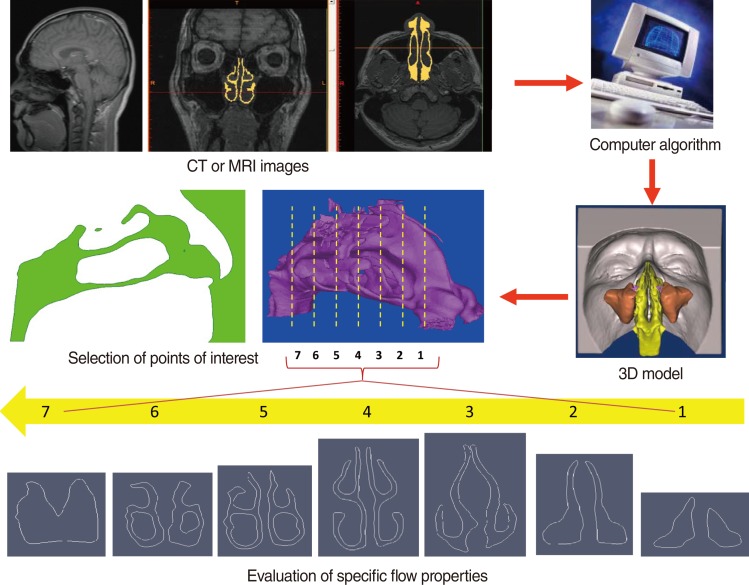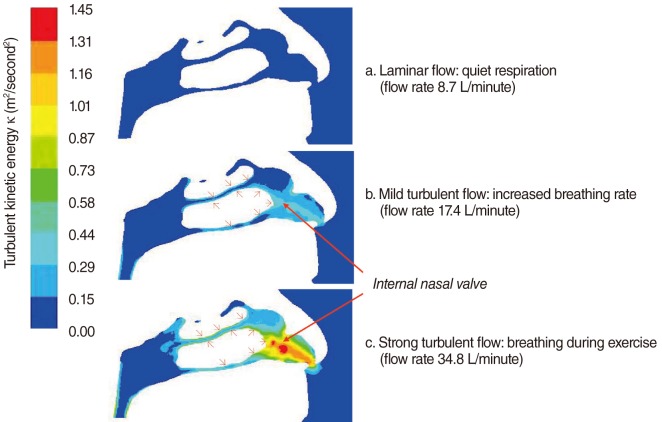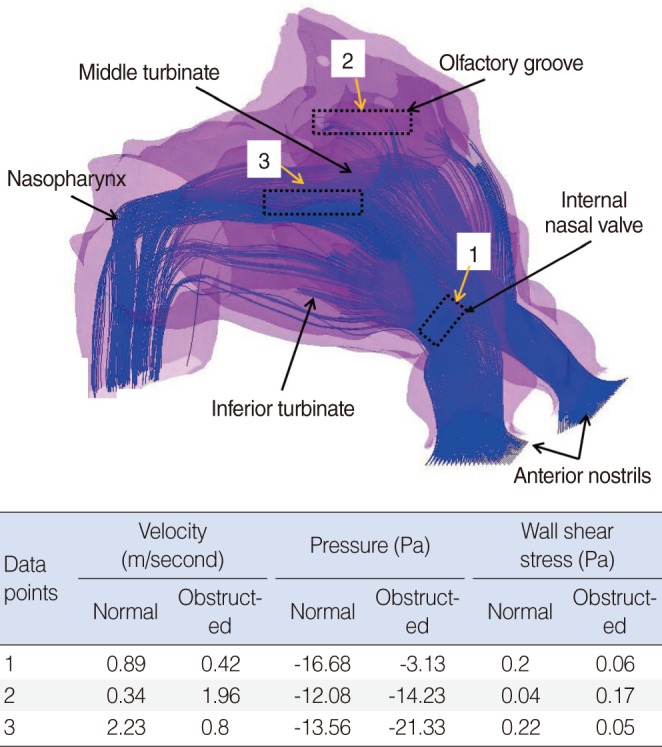Clin Exp Otorhinolaryngol.
2012 Dec;5(4):181-187. 10.3342/ceo.2012.5.4.181.
Impacts of Fluid Dynamics Simulation in Study of Nasal Airflow Physiology and Pathophysiology in Realistic Human Three-Dimensional Nose Models
- Affiliations
-
- 1Department of Otolaryngology, Yong Loo Lin School of Medicine, National University of Singapore, Singapore. entwdy@nus.edu.sg
- 2Department of Engineering, Faculty of Engineering, National University of Singapore, Singapore.
- 3Department of Otology and Laryngology, Massachusetts Eye and Ear Infirmary, Harvard Medical School, Boston and Division of Otolaryngology, Cape Cod Hospital, Hyannis, MA, USA.
- KMID: 1489076
- DOI: http://doi.org/10.3342/ceo.2012.5.4.181
Abstract
- During the past decades, numerous computational fluid dynamics (CFD) studies, constructed from CT or MRI images, have simulated human nasal models. As compared to rhinomanometry and acoustic rhinometry, which provide quantitative information only of nasal airflow, resistance, and cross sectional areas, CFD enables additional measurements of airflow passing through the nasal cavity that help visualize the physiologic impact of alterations in intranasal structures. Therefore, it becomes possible to quantitatively measure, and visually appreciate, the airflow pattern (laminar or turbulent), velocity, pressure, wall shear stress, particle deposition, and temperature changes at different flow rates, in different parts of the nasal cavity. The effects of both existing anatomical factors, as well as post-operative changes, can be assessed. With recent improvements in CFD technology and computing power, there is a promising future for CFD to become a useful tool in planning, predicting, and evaluating outcomes of nasal surgery. This review discusses the possibilities and potential impacts, as well as technical limitations, of using CFD simulation to better understand nasal airflow physiology.
Keyword
MeSH Terms
Figure
Reference
-
1. Keyhani K, Scherer PW, Mozell MM. Numerical simulation of airflow in the human nasal cavity. J Biomech Eng. 1995; 11. 117(4):429–441. PMID: 8748525.
Article2. Castro Ruiz P, Castro Ruiz F, Costas Lopez A, Cenjor Espanol C. Computational fluid dynamics simulations of the airflow in the human nasal cavity. Acta Otorrinolaringol Esp. 2005; 11. 56(9):403–410. PMID: 16353786.3. Martonen TB, Quan L, Zhang Z, Musante CJ. Flow simulation in the human upper respiratory tract. Cell Biochem Biophys. 2002; 37(1):27–36. PMID: 12398415.
Article4. Weinhold I, Mlynski G. Numerical simulation of airflow in the human nose. Eur Arch Otorhinolaryngol. 2004; 9. 261(8):452–455. PMID: 14652769.
Article5. Horschler I, Schroder W, Meinke M. On the assumption of steadiness of nasal cavity flow. J Biomech. 2010; 4. 43(6):1081–1085. PMID: 20080240.6. Leong SC, Chen XB, Lee HP, Wang DY. A review of the implications of computational fluid dynamic studies on nasal airflow and physiology. Rhinology. 2010; 6. 48(2):139–145. PMID: 20502749.
Article7. Pless D, Keck T, Wiesmiller K, Rettinger G, Aschoff AJ, Fleiter TR, et al. Numerical simulation of air temperature and airflow patterns in the human nose during expiration. Clin Otolaryngol Allied Sci. 2004; 12. 29(6):642–647. PMID: 15533152.
Article8. Chen XB, Lee HP, Chong VF, Wang de Y. Numerical simulation of the effects of inferior turbinate surgery on nasal airway heating capacity. Am J Rhinol Allergy. 2010; Sep-Oct. 24(5):e118–e122. PMID: 21244728.
Article9. Keyhani K, Scherer PW, Mozell MM. A numerical model of nasal odorant transport for the analysis of human olfaction. J Theor Biol. 1997; 6. 186(3):279–301. PMID: 9219668.
Article10. Zhao K, Scherer PW, Hajiloo SA, Dalton P. Effect of anatomy on human nasal air flow and odorant transport patterns: implications for olfaction. Chem Senses. 2004; 6. 29(5):365–379. PMID: 15201204.
Article11. Zhao K, Pribitkin EA, Cowart BJ, Rosen D, Scherer PW, Dalton P. Numerical modeling of nasal obstruction and endoscopic surgical intervention: outcome to airflow and olfaction. Am J Rhinol. 2006; May-Jun. 20(3):308–316. PMID: 16871935.
Article12. Kimbell JS, Subramaniam RP. Use of computational fluid dynamics models for dosimetry of inhaled gases in the nasal passages. Inhal Toxicol. 2001; 5. 13(5):325–334. PMID: 11295865.
Article13. Chen XB, Lee HP, Chong VF, Wang DY. Assessment of septal deviation effects on nasal air flow: a computational fluid dynamics model. Laryngoscope. 2009; 9. 119(9):1730–1736. PMID: 19572266.
Article14. Grant O, Bailie N, Watterson J, Cole J, Gallagher G, Hanna B. Numerical model of a nasal septal perforation. Stud Health Technol Inform. 2004; 107(Pt 2):1352–1356. PMID: 15361035.15. Pless D, Keck T, Wiesmiller KM, Lamche R, Aschoff AJ, Lindemann J. Numerical simulation of airflow patterns and air temperature distribution during inspiration in a nose model with septal perforation. Am J Rhinol. 2004; Nov-Dec. 18(6):357–362. PMID: 15706981.
Article16. Lee HP, Garlapati RR, Chong VF, Wang DY. Effects of septal perforation on nasal airflow: computer simulation study. J Laryngol Otol. 2010; 1. 124(1):48–54. PMID: 19775487.
Article17. Chen XB, Lee HP, Chong VF, Wang DY. Assessments of nasal bone fracture effects on nasal airflow: a computational fluid dynamics study. Am J Rhinol Allergy. 2011; Jan-Feb. 25(1):e39–e43. PMID: 21711975.
Article18. Lee HP, Poh HJ, Chong FH, Wang de Y. Changes of airflow pattern in inferior turbinate hypertrophy: a computational fluid dynamics model. Am J Rhinol Allergy. 2009; Mar-Apr. 23(2):153–158. PMID: 19401040.
Article19. Chen XB, Lee HP, Chong VF, Wang DY. Impact of inferior turbinate hypertrophy on the aerodynamic pattern and physiological functions of the turbulent airflow: a CFD simulation model. Rhinology. 2010; 6. 48(2):163–168. PMID: 20502754.
Article20. Wexler D, Segal R, Kimbell J. Aerodynamic effects of inferior turbinate reduction: computational fluid dynamics simulation. Arch Otolaryngol Head Neck Surg. 2005; 12. 131(12):1102–1107. PMID: 16365225.21. Chen XB, Leong SC, Lee HP, Chong VF, Wang DY. Aerodynamic effects of inferior turbinate surgery on nasal airflow: a computational fluid dynamics model. Rhinology. 2010; 12. 48(4):394–400. PMID: 21442074.22. Lee HP, Garlapati RR, Chong VF, Wang DY. Comparison between effects of various partial inferior turbinectomy options on nasal airflow: a computer simulation study. Comput Methods Biomech Biomed Engin. 2011; 9. 14. [Epub]. http://dx.doi.org/10.1080/10255842.2011.609481.
Article23. Lindemann J, Brambs HJ, Keck T, Wiesmiller KM, Rettinger G, Pless D. Numerical simulation of intranasal airflow after radical sinus surgery. Am J Otolaryngol. 2005; May-Jun. 26(3):175–180. PMID: 15858773.
Article24. Chen XB, Lee HP, Chong VF, Wang DY. Aerodynamic characteristics inside the rhino-sinonasal cavity after functional endoscopic sinus surgery. Am J Rhinol Allergy. 2011; Nov-Dec. 25(6):388–392. PMID: 22185741.
Article25. Garlapati RR, Lee HP, Chong FH, Wang DY. Indicators for the correct usage of intranasal medications: a computational fluid dynamics study. Laryngoscope. 2009; 10. 119(10):1975–1982. PMID: 19655385.
Article26. Chen XB, Lee HP, Chong VF, Wang DY. A computational fluid dynamics model for drug delivery in a nasal cavity with inferior turbinate hypertrophy. J Aerosol Med Pulm Drug Deliv. 2010; 10. 23(5):329–338. PMID: 20804427.
Article27. Chen XB, Lee HP, Chong VF, Wang DY. Drug delivery in the nasal cavity after functional endoscopic sinus surgery: a computational fluid dynamics study. J Laryngol Otol. 2012; 5. 126(5):487–494. PMID: 22414292.
Article28. Hooper RG. Forced inspiratory nasal flow-volume curves: a simple test of nasal airflow. Mayo Clin Proc. 2001; 10. 76(10):990–994. PMID: 11605701.
Article29. Lin CL, Tawhai MH, McLennan G, Hoffman EA. Characteristics of the turbulent laryngeal jet and its effect on airflow in the human intra-thoracic airways. Respir Physiol Neurobiol. 2007; 8. 157(2-3):295–309. PMID: 17360247.30. Suh MW, Jin HR, Kim JH. Computed tomography versus nasal endoscopy for the measurement of the internal nasal valve angle in Asians. Acta Otolaryngol. 2008; 6. 128(6):675–679. PMID: 18568504.
Article31. Terheyden H, Maune S, Mertens J, Hilberg O. Acoustic rhinometry: validation by three-dimensionally reconstructed computer tomographic scans. J Appl Physiol. 2000; 9. 89(3):1013–1021. PMID: 10956345.
Article32. Cole P. Acoustic rhinometry and rhinomanometry. Rhinol Suppl. 2000; 12. 16:29–34. PMID: 11225286.33. Eccles R. Nasal airflow in health and disease. Acta Otolaryngol. 2000; 8. 120(5):580–595. PMID: 11039867.
Article34. Cole P. The four components of the nasal valve. Am J Rhinol. 2003; Mar-Apr. 17(2):107–110. PMID: 12751706.
Article35. Farmer SE, Eccles R. Chronic inferior turbinate enlargement and the implications for surgical intervention. Rhinology. 2006; 12. 44(4):234–238. PMID: 17216738.36. Wang DY, Raza MT, Goh DY, Lee BW, Chan YH. Acoustic rhinometry in nasal allergen challenge study: which dimensional measures are meaningful? Clin Exp Allergy. 2004; 7. 34(7):1093–1098. PMID: 15248855.
Article37. Garcia GJ, Bailie N, Martins DA, Kimbell JS. Atrophic rhinitis: a CFD study of air conditioning in the nasal cavity. J Appl Physiol. 2007; 9. 103(3):1082–1092. PMID: 17569762.
Article38. Wen J, Inthavong K, Tu J, Wang S. Numerical simulations for detailed airflow dynamics in a human nasal cavity. Respir Physiol Neurobiol. 2008; 4. 161(2):125–135. PMID: 18378196.
Article39. Lee JH, Na Y, Kim SK, Chung SK. Unsteady flow characteristics through a human nasal airway. Respir Physiol Neurobiol. 2010; 7. 172(3):136–146. PMID: 20471501.
Article40. Cole P. Physiology of the nose and paranasal sinuses. Clin Rev Allergy Immunol. 1998; Spring-Summer. 16(1-2):25–54. PMID: 9561336.
Article41. Hood CM, Schroter RC, Doorly DJ, Blenke EJ, Tolley NS. Computational modeling of flow and gas exchange in models of the human maxillary sinus. J Appl Physiol. 2009; 10. 107(4):1195–1203. PMID: 19608923.
Article42. Naraghi M, Deroee AF, Ebrahimkhani M, Kiani S, Dehpour A. Nitric oxide: a new concept in chronic sinusitis pathogenesis. Am J Otolaryngol. 2007; Sep-Oct. 28(5):334–337. PMID: 17826536.
Article43. Moncada S, Higgs A. The L-arginine-nitric oxide pathway. N Engl J Med. 1993; 12. 329(27):2002–2012. PMID: 7504210.
Article44. Xiong G, Zhan J, Zuo K, Li J, Rong L, Xu G. Numerical flow simulation in the post-endoscopic sinus surgery nasal cavity. Med Biol Eng Comput. 2008; 11. 46(11):1161–1167. PMID: 18726628.
Article45. Bhattacharyya N, Gopal HV, Lee KH. Bacterial infection after endoscopic sinus surgery: a controlled prospective study. Laryngoscope. 2004; 4. 114(4):765–767. PMID: 15064638.
Article46. Nayak DR, Balakrishnan R. De novo bacterial reinfections after endoscopic sinus surgery: can uncinate process preservation surgeries prevent it? Laryngoscope. 2005; 5. 115(5):928. PMID: 15867671.
Article47. Bousquet J, Van Cauwenberge P, Khaltaev N. ARIA Workshop Group. World Health Organization. Allergic rhinitis and its impact on asthma. J Allergy Clin Immunol. 2001; 11. 108(5 Suppl):S147–S334. PMID: 11707753.
Article48. Fokkens W, Lund V, Mullol J. European Position Paper on Rhinosinusitis and Nasal Polyps Group. European position paper on rhinosinusitis and nasal polyps 2007. Rhinol Suppl. 2007; (20):1–136. PMID: 17844873.49. Senocak D, Senocak M, Bozan S. Sinonasal distribution of topically applied particles: computerized tomographic detection and the effects of topical decongestion. Otolaryngol Head Neck Surg. 2005; 12. 133(6):944–948. PMID: 16360518.
Article50. Homer JJ, Maughan J, Burniston M. A quantitative analysis of the intranasal delivery of topical nasal drugs to the middle meatus: spray versus drop administration. J Laryngol Otol. 2002; 1. 116(1):10–13. PMID: 11860644.
Article51. Wenzel A, Henriksen J, Melsen B. Nasal respiratory resistance and head posture: effect of intranasal corticosteroid (Budesonide) in children with asthma and perennial rhinitis. Am J Orthod. 1983; 11. 84(5):422–426. PMID: 6579843.
Article52. Zhu JH, Lee HP, Lim KM, Lee SJ, Wang DY. Evaluation and comparison of nasal airway flow patterns among three subjects from Caucasian, Chinese and Indian ethnic groups using computational fluid dynamics simulation. Respir Physiol Neurobiol. 2011; 1. 175(1):62–69. PMID: 20854936.
Article
- Full Text Links
- Actions
-
Cited
- CITED
-
- Close
- Share
- Similar articles
-
- Nasal Sensation of Airflow: Measurement, Reproducibility and Regional Differences
- The Effects of Various Maxillary Sinus Antrostomy Techniques on Modifying the Ventilation and Air-Conditioning Characteristics of the Maxillary Sinus: A Numerical Study
- Changes of Nasal Airflow Sensitivity in Patients with Chronic Sinusitis
- Submucosal Gland in Nose
- Application of three-dimensional printing technology and Plan-Do-Check-Act (PDCA) cycle in deviated nose correction




